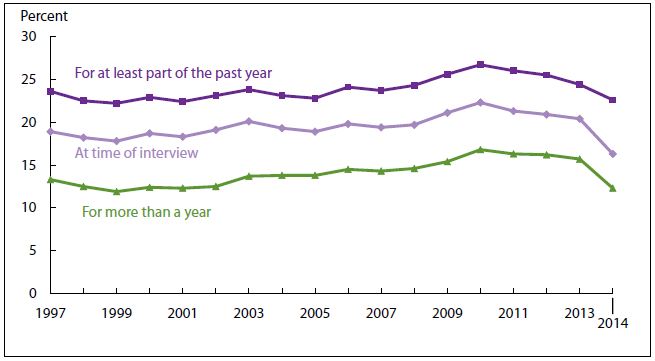
Percentage of adults 18-64 who lacked health insurance coverage, 1997-2004. Graphic credit: National Health Interview Survey
by James A. Bacon
After all the strum and drang over Obamacare, the restructuring of the United States health care system, the re-engineering of the medical insurance industry and dislocation to millions of Americans who discovered they could not necessarily keep their doctor or their health care plan, even if they liked it, it turns out that the piece of the program that made the biggest difference in increasing health coverage for the American people was Medicaid expansion. Take that away, and the number of Americans lacking health care coverage declined only slightly — and the reasons for that decline are not clear.
That’s not the spin put on the numbers you’ll read in the media. (See the Richmond Times-Dispatch spin here.) But it’s certainly a legitimate interpretation of the numbers reported by the 2014 National Health Interview Survey, which is not a libertarian think tank or funded by the evil Koch Brothers but a program of the National Center for Health Statistics.
The number of Americans under 65 years old covered by the infamous health care exchanges amounted to 6.7 million — or about 2.5% of that segment of the population. (Remember, that number includes Americans who previously had private insurance and found themselves bumped into an exchange.) That compares to 170 million, or 63.6%, who were covered by private health insurance plans, and 36 million (11.5%) of Americans without any kind of insurance, public or private.
A major driver behind the improved numbers was expansion of Medicaid. Among working-age adults in states that expanded Medicaid, states the report, the percentage with Medicaid coverage expanded from 17.7% in 2013 to 19.9% in 2014 — a gain of 2.2 percentage points, while comparable adults in states that did not expand Medicaid, like Virginia, saw no significant change in public coverage. Literally half the gains in the insurance-coverage rate could have been achieved by expanded Medicaid (in the states that chose to expand it) and scrapping the rest of Obamacare.
Here are the Virginia numbers for all ages:
Private health coverage — 67.0%
Public health coverage — 31.3%
Uninsured — 10.8%
Lost in the weeds is the bigger picture. Look at the chart of uninsured Americans at the top of the page. While the number of uninsured dropped significantly between 2013 and 2014, the uninsured population had been shrinking since 2010 at the worst of the Great Recession. Significant gains in insurance coverage occurred simply as the result of increasing employment.
Now compare the 2014 numbers to the 1999 numbers — the number of uninsured is about the same. Anyone remember 1999? That was the tail end of the Clinton-era Internet boom. Unemployment was exceedingly low. The best way to ensure that Americans enjoy health care insurance is to ensure that they have a job. Not every job provides medical coverage but most do. The more employers find themselves competing for labor, the more likely they are to provide some level of medical insurance.
Instead of pursuing macro-economic reforms and institutional reforms that bolster productivity and sustainable economic growth, the United States got a one-shot stimulus plan, higher taxes, more regulation, Obamacare and sub-par economic growth. While Americans have made marginal gains in gaining access to health insurance, thanks to Obamacare, we’re also experiencing a consolidation of the hospital industry into a handful of cartel-like “health systems,” the conversion of physicians from independent providers into salaried minions of hospitals, and a consolidation of the health insurance industry. The health care industry is becoming stodgier, more bureaucratic, more risk averse, more prone to rent-seeking and less interested in innovation. For marginal gains in the percentage of the insured population, we will all be losers in the long run.


